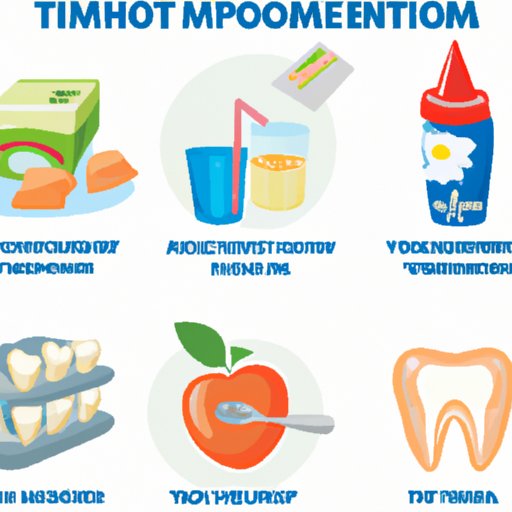
I. Introduction
If you’ve recently had a tooth extraction, one of the first things on your mind may be, “When can I eat again?” Eating after tooth extraction requires careful planning and consideration to ensure a safe and healthy recovery. In this article, we will take you through a step-by-step guide on how to eat after tooth extraction, which foods to avoid and which foods to eat, how to manage pain and swelling, and the importance of proper nutrition while recovering.
II. A Step-by-Step Guide to Eating After Tooth Extraction
Before you start eating again, it’s important to know when it’s safe to do so. Generally, you should wait at least a couple of hours after the tooth extraction procedure to start eating anything. It’s best to start with clear or liquid foods that are easy to swallow, such as broths and soups. Gradually, you can start eating mashed or pureed foods, then soft foods that require chewing.
While you’re eating, be sure to chew slowly and carefully and avoid biting down directly on the extraction site. If your jaw is sore or stiff, you can try opening and closing your mouth slowly a few times before eating to loosen up your muscles. You can also try taking a pain reliever about 30 minutes before your meal to help reduce discomfort.
III. Foods to Avoid and Foods to Eat After Tooth Extraction
After tooth extraction, your mouth needs time to heal, so it’s important to avoid certain foods that can irritate or damage the extraction site. Avoid hard, crunchy, or chewy foods like chips, nuts, popcorn, and candy for at least a week or two after the procedure. Acidic and spicy foods should also be avoided as they can cause further irritation and discomfort.
Instead, focus on soft, nutritious foods like yogurt, mashed potatoes, scrambled eggs, soup, and protein shakes. You can gradually introduce foods that require more chewing, such as cooked vegetables, pasta, and soft meats.
IV. How to Manage Pain and Swelling While Eating After Tooth Extraction
It is common to feel some pain, swelling, and discomfort for several days after a tooth extraction. To manage pain while eating, try taking pain medication before meals. You can also try holding a cold pack or ice wrapped in a towel against your cheek or jaw before eating to help reduce swelling and numb the area.
Be sure to avoid hot foods and beverages, as the heat can cause increased blood flow and swelling in the extraction site. Instead, try eating cold foods and beverages or foods at room temperature.
V. The Importance of Nutrition After Tooth Extraction and How to Get the Nutrients You Need
While you’re healing, it’s important to eat a balanced and nutritious diet to help your body recover. Adequate protein, vitamins, and minerals will help your body repair damaged tissue and promote healing.
Focus on foods that are nutrient-dense, such as lean protein like chicken and fish, vegetables, fruits, and whole grains. If you’re having difficulty getting the nutrients you need from your regular diet, talk to your dentist or oral surgeon about recommended supplements.
VI. Alternative Options for Meal Replacement After Tooth Extraction
If you’re having difficulty chewing or swallowing, or if you need to stick to a liquid or pureed diet, there are alternative meal replacement options available. You can choose from ready-made protein shakes and smoothies, or you can make your own by blending soft foods like yogurt, bananas, and avocado.
You can also try blending soft or pureed foods like soups, stews, and casseroles to make them easier to eat. Just be sure to avoid adding any hard or crunchy ingredients like nuts or croutons, and watch out for spices or seasonings that can cause irritation.
VII. Questions to Ask Your Dentist or Oral Surgeon About Eating After Tooth Extraction
It’s important to communicate with your dentist or oral surgeon about your specific case and nutritional needs. Be sure to ask questions about what to eat, when to eat, and how to manage pain and swelling. Your dental provider can also give you recommendations for supplements or meal replacement options to help you stay on track with your recovery plan.
VIII. Conclusion
Eating after tooth extraction requires careful planning and consideration, but with proper care and a nutritious diet, you can ensure a safe and speedy recovery. Focus on soft, nutritious foods, and avoid anything that can cause irritation or damage to the extraction site. Don’t hesitate to ask your dental provider any questions or concerns you may have, and prioritize your health and wellness as you move forward in your healing process.




